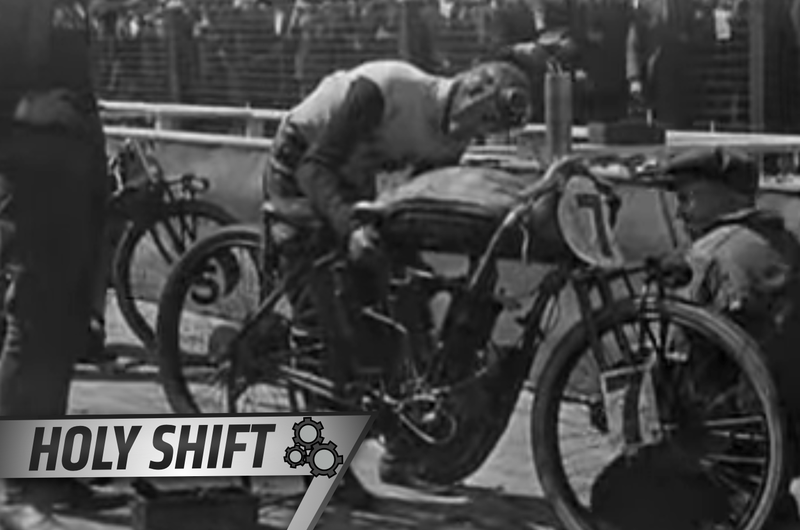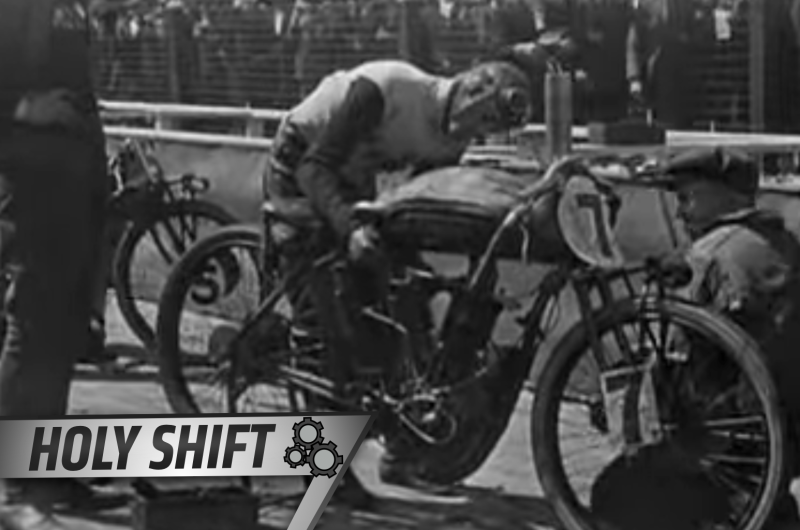
Racing is inherently dangerous, and that danger presents itself each time a vehicle rolls onto a track. Racing communities, in turn, continually make calls for safer conditions. But motorsport was far more risky in the days of wooden tracks and “murderdome” racing without brakes, and that didn’t last long at all.
Happy Sunday! Welcome to Holy Shift, where we highlight big innovations in the auto and racing industries each week—whether they be necessary or simply for comfort—and, on occasion, weird car history.
When the earliest cars and motorcycles rolled off the line, it wasn’t long before they lined up on the track for a test of speed. While both cars and motorcycles participated in the board-track era of racing, motorcycles identified with the discipline more—cars had road courses, streets, ovals, board tracks and the like to race on elsewhere, but motorcycle board-track racing was a spectacle that popped up throughout the U.S. soon after it began.
Advertisement
According to the Smithsonian, the first mass-produced American motorcycle, the Indian, came out in 1901. Harley Davidson introduced a bike in 1903, and riders headed to horse tracks and high-banked velodromes used for bicycle racing in order to compete. Wooden tracks built specifically for motorcycle and car racing appeared just a handful of years later in 1909, per the Smithsonian, sprinkling California with additions to the landscape and the entertainment lineup.
But the high entertainment value came with even higher levels of danger, for both riders and drivers. That led newspapers to refer to the “motordomes” as “murderdomes” beginning midway through the 1920s, when the discipline was already on the decline.
Sponsored
That danger came from all around—the speeds, the track surface, the spectator placing and the lack of brakes in the motorcycles. The tracks had high banking that sometimes reached over 60 degrees, according to the Huffington Post. For comparison, that’s nearly twice the 33-degree banking in the turns of Talladega Superspeedway. The banking led drivers and riders to shoot up the track as Gaston Chevrolet did in his fatal two-car wreck at Beverly Hills Speedway, a famous board track that was just over a mile in length. Motorcycles could reach over 100 mph on certain tracks as well, per the Smithsonian.
But the danger got much more gruesome than that. As the Smithsonian puts it:
Crashes were frequent and horrific—riders who went down faced being impaled by splinters—and often fatal. Spectators shared in the risk: at many motordromes, they peered down from the lip of the track, in harm’s way. On one particularly lethal day in 1912, several observers—from four to six, accounts vary—were killed along with Eddie Hasha and another rider at a motordrome in Newark, New Jersey, when Hasha lost control of his bike and slammed into the crowd.
The discipline was popular, though—for about 20 years. Per Road & Track, there were about two dozen board tracks around the U.S. during its days of popularity. Just look at the attendance numbers at this Beverly Hills Speedway race in 1921, only 10 years after board tracks began their reign in American motorcycle racing —12,000 people showed up to watch Albert “Shrimp” Burns take the victory:
Advertisement
Burns died in a racing crash in Toledo, Ohio in later that year, according to the Smithsonian. Board tracks lived on for about 10 years after that, but faced a sharp decline at the start of the 1930s. The Smithsonian attributes the negative tone toward “murderdomes” in the papers, the attempts by manufacturers to slow down the motorcycles and the closing of some tracks by local governments to the demise of board-track racing. According to Road & Track, only four board tracks were left in the U.S. by 1931.
As with all things, motorcycle racing evolved from one of its most famous early states to become what it is today. Really, board-track racing was just a blip in history that helped to put U.S. motorcycle racing on the map—on several maps, even—at the cost of death and danger.
Racing can always be safer, but it’s important to remember how much safety standards have improved since the inception of motorsport. Spectator harm is a rare occurrence in modern racing, and a face full of splinters would only be possible if riders and drivers carried firewood along with them. That doesn’t sound like the best good-luck charm, but perhaps it’s a thing.
If you have suggestions for future innovations or historical notes to be featured on Holy Shift—in street cars, the racing industry or whatever you’d like—feel free to send an email to the address below or leave them in the comments section. The topic range is broad, so don’t hesitate with your ideas.















